“Are we a city or town? If you’re from Kilkenny, you’ll only refer to the place as a city — we were even the capital of Ireland in the 1600s. We’re always punching above our weight!”
So says Nevin Cody from the award-winning Shenanigans Walks. Given Kilkenny’s past success in trading, it’s no surprise that these locals know how to market themselves. Even their marble — which gives this South-East destination its moniker — is, in fact, highly polished limestone.
While its city status has changed over the years, Kilkenny’s beauty has been constant. Framed by the river Nore — and currently teeming with hip cafés, bars and independent stores — it’s undoubtedly one of the brightest jewels in Ireland’s crown. Thanks to its proximity to Dublin, it’s also a haven for tourists — evidenced by the crowds lining the streets.
Nevin, who incorporates his love of magic into his tours, guides me along the Medieval Mile, a route bookended by the castle and St Canice’s Cathedral — called after the saint who gives Kilkenny its name. Outside the stone-clad courthouse or Kyteler’s Inn — home of ‘witch’ Alice Kyteler, whose maid Petronilla de Meath was the first person in Ireland burnt at the stake — he deftly performs his own sorcery with the help of books, balloons and ropes.

St. Canice's Cathedral.
That’s when he’s not bringing past eras to life by revealing the amusing etymology behind well-known phrases, like ‘stinking rich’ and ‘upper crust’ — or describing the two fabled fighting felines responsible for giving Kilkenny people the nickname, the ‘cats’.
Take me to church
So that I can learn more about Kilkenny’s embarrassment of riches, Nevin passes the baton — or in this magician’s case, the ‘wand’ — to another local tour guide, James Sherman, in St Canice’s, the second longest cathedral in Ireland.
While this Church of Ireland building dates from the 13th century, the site has witnessed Christian worshipping since the 6th century. The 100-foot round tower — only one of two in the country that people can still climb — has been watching over the region for 1,200 years.
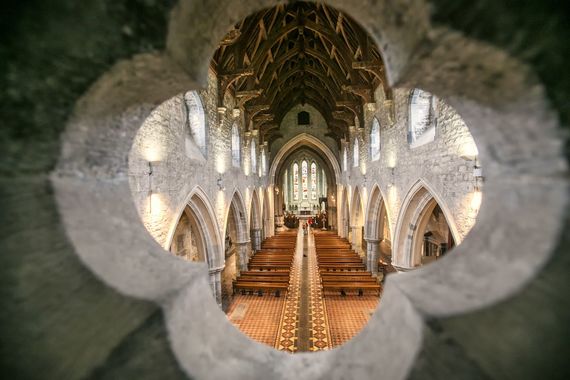
Saint Canice's Cathedral.
Amongst the cathedral’s notable features, James mentions that St Canice’s claims the country’s most extensive collection of funeral monuments, a 3,000-pipe organ and 19th-century Canadian redwood ceilings. One of the stained-glass windows — Alfred Ernest Childe’s nativity scene — even featured on an Irish stamp.
“We’re the only cathedral worldwide to have two thrones,” he proudly adds, describing how St Kieran’s chair, relocated here from Aghaboe Abbey in 1111, became no longer fit for purpose, resulting in the addition of an alternative. Because of the historical significance of this ancient chair, it was never deconsecrated, affording the cathedral this prestigious distinction.
A man's home is his castle
Kilkenny Castle mightn’t possess a throne, but between 1391 and 1935, it was the seat of an influential family — the Butlers of Ormonde. Few buildings on the island claim a more extended history of continuous occupation.
“Castles don’t make great homes,” says guide John Kelly. “Unlike palaces, they’re not built for comfort and were better as defensive structures, prisons or administrative buildings. But the Butlers stuck it out!”
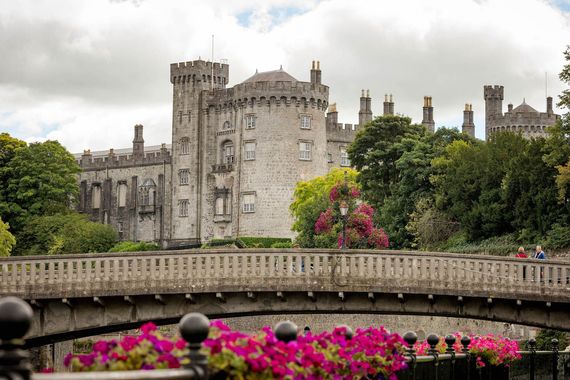
Kilkenny Castle and gardens.
The castle was founded following the Norman invasion in the 12th century — and famous figures associated with the structure in its early years include Strongbow and his son-in-law, William Marshall. Over the next 800 years, the castle shapeshifted — a notable change is the absence of the south wall and tower. Its current incarnation is essentially a Victorian remodeling.
Among the residents to call Kilkenny Castle home include Lady Margaret Butler, grandmother of Anne Boleyn — the unfortunate wife of King Henry VIII of England. After the family left the castle in the 20th century, it lay abandoned for 30 years — the government eventually bought it in 1967 for just £50.
While there’s much to admire here — including the Moorish staircase, a beautifully reproduced library and the temporary Ros Tapestry exhibition — the Picture Gallery truly has “the wow factor”, as John describes it, noting the style is Castellated Baronial. The ceiling — an echo of St Canice’s Cathedral — calls to mind an upturned Viking ship while nature and folklore, dominant themes during this era, are evident throughout.
"To be forgotten is to die twice"
Ireland’s darkest days are sensitively remembered in my next stop. In 2005, while constructing MacDonagh Junction Shopping Centre on the site of a Famine workhouse, over 976 human remains were discovered.
“It was the largest mass burial site ever unearthed in Ireland and triggered extensive osteological research,” the center’s manager, Marion Acreman, tells me. “Our challenge then was — can a commercial space sit alongside this devastating history? So, we created Kilkenny Famine Experience — a free audio-visual trail documenting the stories of the inmates who lived and died within these walls.”
She cites French philosopher Paul Ricoeur, “To be forgotten is to die twice” — a quote that’s poignantly interwoven throughout the trail.
Walking around the site, I listen to the heartbreaking stories of our ancestors, emaciated and broken — and unable to sleep because of the cries of parents and children, separated into different wings and desperate to be reunited.
These vivid recollections starkly contrast with the scenes around me today — families full of Christmas cheer, shopping or enjoying lunch. It reinforces the importance of this trail — in addition to commemorating the past, it reminds us of our many blessings today.
Outside, in the Famine Memorial Garden, a beautiful statue symbolizes hope and new beginnings and commemorates two young brothers, John and Patrick Saul, who sought refuge in the workhouse in 1841.
Marion describes some other projects the center has developed with the community.
“We invited 976 people to each learn about one of the 976 victims — the participants’ signatures and fingerprints were then etched in brass in the memorial garden.
“We’ve also welcomed descendants of the 59 orphan girls who left Kilkenny for Australia under the Earl Grey scheme. That was an emotional experience for everyone.”
Wet your whistle
En route to my next stop, I browse the exhibitions in the stunning Butler Gallery — a former military barracks developed into a home for servants in 1818, thanks to Joseph Evan, a descendant of an English soldier.
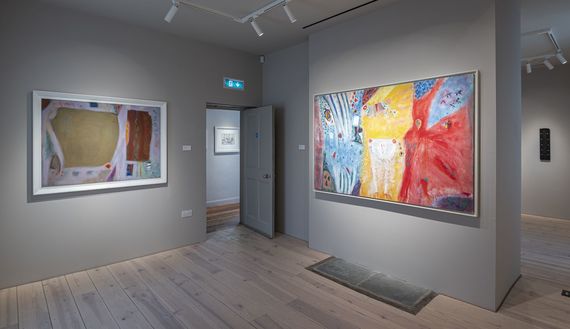
Butler Gallery.
Today, it’s one of the country’s leading contemporary art galleries and museums — I marvel at the diverse exhibitions by famed Irish artists, including Paul Henry, Louis le Brocquy, Mainie Jellett, Patrick Scott and Evie Hone.
Back on the Medieval Mile — and located directly opposite the stunning 16th-century merchant’s townhouse, Rothe House — I find Smithwick’s Experience. Here, the story of the world’s most popular ale is brought to life in their former brewery.
While this red-colored tipple can be traced to the 13th-century Franciscan monks living in the adjacent abbey, it was in 1710, after John Smithwick joined forces with Richard Cole, that the iconic brand was created.
Now brewed in Dublin, the tour — which includes demonstrations and tastings — cleverly brings the storied history to life. Along with insights about the family and brewing process, I learn about strict penal laws, which threatened to thwart the ambitions of John, a Catholic.
“We welcome visitors who are fans of Smithwick’s and visitors who haven’t heard of it yet,” says guide Joe Reid. “No matter their relationship to the brand, they love the interactive elements here as they receive an opportunity to stir, grind and smell the ingredients.”
Birds of a feather
Somewhere that also boasts all the right ingredients is my accommodation, Lyrath Estate — a 17th-century property that sits effortlessly alongside a modern extension.
“The hotel perfectly marries the old with the new,” manager Susan Lanigan says of the five-star property that opened in 2006 — and somehow succeeds in being both sprawling and intimate at once. “Our guests always mention the atmosphere, and I know exactly what they mean — I love working here.”
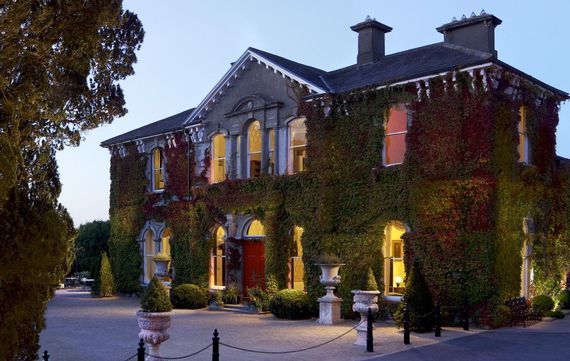
Lyrath Estate.
Some of the guests Susan refers to are international tour groups who praise the welcome they receive from the warm staff along with the trio of dining options — Tuppers Bar, Yew Fine Dining Restaurant and, my favorite, the Grill and Bar. There, perched above the reception area, I devour a Tomahawk steak during my stay.
It’s no surprise that Lyrath Estate’s 141 bedrooms are constantly in demand by guests, drawn to the property’s eclectic and elegant décor. Even though the hotel is located just minutes outside Kilkenny, Susan mentions patrons feel “far away from the hustle and bustle” thanks to the surrounding 170 acres of lush parkland.
In addition to their restaurants and multi-award-winning spa, which Susan describes as a “sanctuary of tranquillity”, another selling point for the hotel is Hawkeye Falconry Ireland, located on the estate. This recently launched school offers guests a unique opportunity to fly, handle and feed trained hawks and owls.
“We’ve had guests who were afraid before trying it,” Susan says, “and within seconds, they’re converted.”
I am one such person. After signing up for a lesson — which also serves as my last activity in Kilkenny — I don my finest tweed and Wellington boots but feel a trepidation kick in. Owners John and Caroline Duggan immediately allayed my fears.
“Even before recorded history, our ancestors flew birds of prey,” John, from the neighboring county of Waterford, tells me. “It’s often described as the noblest of all field sports.”
He also reveals that today, falconry is practiced in over 60 countries — in 14 of them, including Ireland, UNESCO lists it as an intangible cultural heritage.
As a child, John first developed his passion for falconry by reading medieval history — later, he successfully petitioned his parents to allow him to adopt a rehabilitated falcon. Through John, Caroline developed a similar love for birds. Overcoming life-threatening illnesses encouraged them both to turn this passion into a career.
“I feel like the luckiest man in the world getting to be around these magnificent creatures every day,” John readily admits, his devotion to the animals clearly evident in how lovingly he communicates with them.
It’s hard to overstate how humbling and emotional I become when Turbo, the orange-eyed owl, and Holly, the Harris Hawk, land on my gloved hand for morsels of food.
“Holly loves being with you, but she also loves hunting,” John explains — a fact borne out when we roam a nearby field, and she spies her surroundings for prey — including a dandelion; the seeds apparently mesmerize her!
“Falconry is very therapeutic,” John correctly observes. “Not only do you have this unique link to nature, but the presence of these hunting animals, so close, is incredibly powerful.”
Caroline adds: “We had a 90-year-old man visit here recently. He thought he was too old to learn anything new — he said the experience gave him a new lease on life.”
And I can’t think of a better endorsement of falconry than that.
For more information, see visitkilkenny.ie.
*Originally published in January 2024. Updated in May 2024.
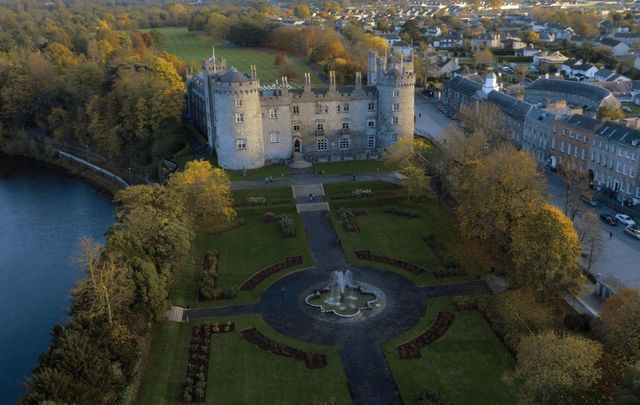


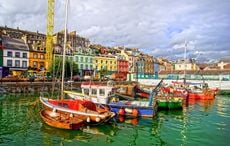
Comments